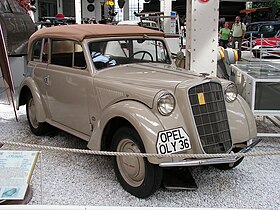Opel Olympia
| Opel Olympia | |
|---|---|

1936 Opel Olympia
|
|
| Overview | |
| Manufacturer | Opel (General Motors) |
| Production | 1935–1970 |
| Body and chassis | |
| Class | Compact / Small family car (C) |
| Chronology | |
| Predecessor | Opel 1.3 litre |
| Successor | Opel Rekord/Opel Ascona |
| Opel Olympia | |
|---|---|
 |
|
| Overview | |
| Production | 1935–1937 81,661 produced |
| Body and chassis | |
| Body style | 2-door saloon 2-door cabriolet |
| Powertrain | |
| Engine | 1.3 L Straight-4 side valve |
| Transmission | 3 or 4 speed manual |
| Dimensions | |
| Wheelbase | 2.37 m (93.3 in) |
| Length | 3.93 m (154.7 in) |
| Width | 1.43 m (56.3 in) |
| Opel Olympia OL38 | |
|---|---|
 |
|
| Overview | |
| Production | 1937–1940 1947–1949 |
| Body and chassis | |
| Body style | 2-door saloon 4-door saloon 2-door cabriolet |
| Powertrain | |
| Engine | 1.5 L Straight-4 ohv |
| Dimensions | |
| Wheelbase | 2.43 m (95.7 in) |
| Length | 4.02 m (158.3 in) |
| Width | 1.50 m (59.1 in) |
| Opel Olympia 1950 | |
|---|---|
 |
|
| Overview | |
| Production | 1950–1953 |
| Body and chassis | |
| Body style | 2-door saloon 2-door convertible 2-door estate |
| Powertrain | |
| Engine | 1,5 L straight 4 OHV |
The Opel Olympia is a compact car produced by the German automaker Opel from 1935 to 1940, from 1947 to 1953 and again from 1967 to 1970.
The 1935 Olympia was Germany's first mass-produced car with an all-steel unitized body (monocoque). This revolutionary technology reduced the weight of the car by 180 kilograms (400 lb.) compared to its predecessor. Production of the unibody design required new production methods and materials. Spot welding, advanced types of steel, and a new production line layout were among the many advances introduced by the Olympia.
The car was first presented in February at the 1935 Berlin Motor Show; production got under way later during that year. The Olympia was named in anticipation of the 1936 Berlin Olympic Games. Before World War II it was made in two versions. From 1935 to 1937 the Olympia had a 1.3-litre engine. For the OL38 version made from 1937 to 1940 this was replaced by a 1.5-litre overhead valve unit.
Between 1935 and the 1940 over 168,000 units were built.
The name Olympia was revived in 1967 for a luxury version of the Opel Kadett B.
At 2500 Reichsmark it offered a true four-seater with 1.3-litre, 4-cylinder, side-valve, 24 hp (18 kW) engine capable of 100 km/h (62 mph). Drive was to the rear wheels through a three speed gearbox but a four speed unit became available in 1937. The car had independent front suspension with a live axle at the rear and semi-elliptic leaf springs.
The car was made available in two versions, as a two-door saloon and as a two-door soft-top convertible:
A new engine was introduced in 1937 with a capacity of 1488 cc and overhead valves. It produced 37 hp (27 kW) and the top speed of the car was 112 km/h (70 mph). The car's body received a facelift.
It was available in the same versions as its predecessor with the addition of the 6-light LV:
Due to World War II, production came to a halt in late 1940. During the war, the Opel plant in Rüsselsheim was severely damaged by allied bomb attacks. After reconstruction, production of the Olympia restarted in late 1947. The OL 38 was unchanged to the pre-war car but only the two door sedan was produced. Until the end of 1949, 25.952 of them were made.
...
Wikipedia
